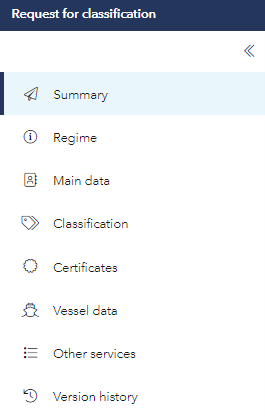

The request for classification tool can be accessed from the Classification of Newbuilding project list by using the ‘Class request’ link on the top header.
The request for classification overview contains table with all requests, both historical and ongoing. The table consist of the following columns:

A new request for classification can be made by clicking ‘Create request’ button. An existing request can be re-visited by clicking the row. A request for classification can be made and edited by a yard user or a DNV representative for collaboration with the yard.
Free text filter and status filter above the overview list can help you filter the list by free text or selected status.
The request for classification menu contains name for the request, version history with changes, regime, main data, classification, certificates, vessel data, verify & submit and summary. The request can be saved by pushing the Save button in the menu to the left. Please note that most drop-down menus also have free text search for easier use.

The Regime page is the first page inside the request.
Each request must be given a name. It is advisable to use a unique name for easy identification in the list of current and historical requests.
It is important that correct regime (ships, offshore units, naval vessels etc.) and vessel purpose is chosen at the very beginning since this affects remaining inputs applicable rules. Changing the regime will reset parts of the request and data will be lost. You are therefore required to select both regime and main vessel purpose before you continue with the rest of the application. If you have difficulties finding the correct regime for your vessel, please contact your local DNV station.
Structural design type describes the vessel hull. If you are not able to find a suitable type, you should consider changing regime and try again.
The vessels main characteristics should be set in main data.
“Main propulsion principle” means the propulsion driver. For a vessel with a propeller connected to a shaft which is driven by a combustion engine (MDO, Heavy fuel oil etc.) directly or through a gear box, the correct answer is "CE combustion engine". If the shaft or thruster is rotated by an electrical motor the correct answer is EL Electric motor. Other principles used for propulsion shall be stated in “Additional propulsion principle”.
Vessel dimensions and construction material should be stated.
If all parts of the vessel are built at the same yard, contractual builder, hull yard and outfitting yard should be identical. Same goes for the building numbers.
Designer type designation means the model name from the designer.
Date of contract between yard and owner shall be stated. The rule edition will be dependent on this date. Please use "Additional Service/Information" field in “Compliance Documents” and contact your local station if a different Rule edition is desired.
It is possible to add vessels into the request. Building number and milestones should be selected for each vessel.
Rule set, construction symbol, rule edition and main class notation is presented in Classification. Relevant class notations can be selected by using the scroll and/or search functionality in the drop-down menu.

All your selected class notations will have a group view in the "Selected class notations".
The class notation presentation can be edited by ticking on/off ‘Selected only’, ‘Descriptions’ and ‘Code’.

Relevant compliance documents can be selected by using tick-of. It is also possible to use Free text filter.
Please note that DNV will review if they are authorized to do selected scope on behalf of flag after the class request is submitted. It might be necessary to change type of selected compliance document and/or apply for case-by-case authorization from flag. Chosen compliance documents are presented if ‘Selected only’ is activated.
If you have additional service, additional declarations, or other important information to DNV which not included in the compliance document list, please state them in the ‘Additional Service/Information’ field.
Information about the vessel should be set in vessel data. This information will be used to create DNV’s product model of the vessel which again will be used to give the yard early information about certificate requirements, survey requirements and documentation requirements (DOCREQ).

It is possible to add other services from this task:
* Final enrolment to DNV ERS™ is subject to separate contract between owner/manager and DNV ERS™. For vessels in operation, enrolment to DNV ERS™ or similar service is a prerequisite for CLEAN and CLEAN DESIGN notation, ref. DNVGL-RU-SHIP-Pt6 Ch7 Sec.2. Table 1. For vessels with Class notation FCS and qualifier (HF), enrolment to DNV ERS™ is mandatory.
** Covered when COMF notation is ordered
The ‘Summary’ task contains summary of the input given in the request for classification tool.
You can click ‘Change status’ when you are ready to submit the request to DNV.
Please read through all input and check that it is correct before submitting your request for classification.
After the request has been submitted, the 'submit' and 'delete' buttons will be removed and it's no longer possible to delete or submit this.
After the request has been submitted, the request will be locked for changes.
If the request you have submitted needs to be returned to draft for editing, please contact your key account manager.
The request will then be reviewed by DNV and possible adjustments will be communicated and agreed. When the request is reviewed and/or verified, status will be updated. More information about the different statuses can be found in Request for classification overview in this user manual.

Draft version of Request for Classification can be deleted. Go to ‘Change Status’ and tick ‘We confirm that the request should be deleted’, then click ‘Delete’. By doing this, all data under this request for classification will be lost.